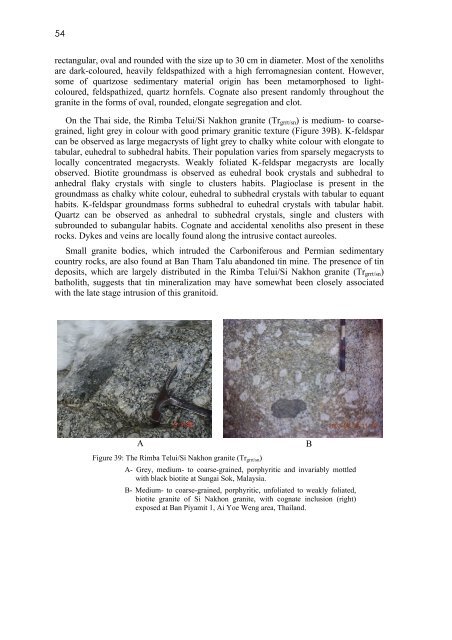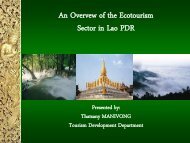GEOLOGY OF THE PENGKALAN HULU-BETONG TRANSECT ...
GEOLOGY OF THE PENGKALAN HULU-BETONG TRANSECT ...
GEOLOGY OF THE PENGKALAN HULU-BETONG TRANSECT ...
Create successful ePaper yourself
Turn your PDF publications into a flip-book with our unique Google optimized e-Paper software.
54<br />
rectangular, oval and rounded with the size up to 30 cm in diameter. Most of the xenoliths<br />
are dark-coloured, heavily feldspathized with a high ferromagnesian content. However,<br />
some of quartzose sedimentary material origin has been metamorphosed to lightcoloured,<br />
feldspathized, quartz hornfels. Cognate also present randomly throughout the<br />
granite in the forms of oval, rounded, elongate segregation and clot.<br />
On the Thai side, the Rimba Telui/Si Nakhon granite (Trgrrt/sn) is medium- to coarsegrained,<br />
light grey in colour with good primary granitic texture (Figure 39B). K-feldspar<br />
can be observed as large megacrysts of light grey to chalky white colour with elongate to<br />
tabular, euhedral to subhedral habits. Their population varies from sparsely megacrysts to<br />
locally concentrated megacrysts. Weakly foliated K-feldspar megacrysts are locally<br />
observed. Biotite groundmass is observed as euhedral book crystals and subhedral to<br />
anhedral flaky crystals with single to clusters habits. Plagioclase is present in the<br />
groundmass as chalky white colour, euhedral to subhedral crystals with tabular to equant<br />
habits. K-feldspar groundmass forms subhedral to euhedral crystals with tabular habit.<br />
Quartz can be observed as anhedral to subhedral crystals, single and clusters with<br />
subrounded to subangular habits. Cognate and accidental xenoliths also present in these<br />
rocks. Dykes and veins are locally found along the intrusive contact aureoles.<br />
Small granite bodies, which intruded the Carboniferous and Permian sedimentary<br />
country rocks, are also found at Ban Tham Talu abandoned tin mine. The presence of tin<br />
deposits, which are largely distributed in the Rimba Telui/Si Nakhon granite (Trgrrt/sn)<br />
batholith, suggests that tin mineralization may have somewhat been closely associated<br />
with the late stage intrusion of this granitoid.<br />
A<br />
Figure 39: The Rimba Telui/Si Nakhon granite (Trgrrt/sn)<br />
A- Grey, medium- to coarse-grained, porphyritic and invariably mottled<br />
with black biotite at Sungai Sok, Malaysia.<br />
B- Medium- to coarse-grained, porphyritic, unfoliated to weakly foliated,<br />
biotite granite of Si Nakhon granite, with cognate inclusion (right)<br />
exposed at Ban Piyamit 1, Ai Yoe Weng area, Thailand.<br />
B



